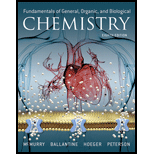
Fundamentals of General, Organic, and Biological Chemistry (8th Edition)
8th Edition
ISBN: 9780134015187
Author: John E. McMurry, David S. Ballantine, Carl A. Hoeger, Virginia E. Peterson
Publisher: PEARSON
expand_more
expand_more
format_list_bulleted
Textbook Question
Chapter 1, Problem 1.116GP
Sulfuric acid (H2SO4, density 1.83 g/mL) is produced in larger amounts than any other chemical: Global production exceeded 230 million metric tonnes in 2012 and is projected to exceed 267 million tonnes by 2016. What was the volume of this amount (in liters) produced in 2012? What are the most common applications of sulfuric acid?
Expert Solution & Answer
Want to see the full answer?
Check out a sample textbook solution
Students have asked these similar questions
2. (20 points) Consider combustion of hydrogen gas in a mixture
of hydrogen and oxygen adjacent to the metal wall of a
combustion chamber. Combustion occurs at constant
temperature and pressure according to the chemical reaction
2H₂+ O₂→ 2H₂O. Measurements under steady-state conditions
at 10 mm from the wall indicate that the molar concentrations
of hydrogen, oxygen, and water vapor are 0.10, 0.10, and 0.20
kmol/m³, respectively. The generation rate of water vapor is
0.96x102 kmol/m³s throughout the region of interest. The binary
diffusion coefficient for each of the species (H, O̟, and H₂O) in
the remaining species is 0.6 X 10-5 m²/s.
(a) Determine an expression for and make a qualitative plot
of C as a function of distance from the wall.
H2
(b) Determine the value of C2 at the wall.
H2
(c) On the same coordinates used in part (a), sketch curves
for the concentrations of oxygen and water vapor. This will
require you to calculate Co, and C.
02
H20
(d) What is the molar flux of water…
4. (15 points) Consider a spherical organism of radius ro within
which respiration occurs at a uniform volumetric rate of That is,
oxygen (species A) consumption is governed by a first- order
reaction, homogeneous chemical reaction.
a. If a molar concentration of CA(ro) = CA,o is maintained at
the surface of the organism, obtain an expression for the
radial distribution of oxygen, CA(r), within the organism.
Hint: To simplify solution of the species diffusion equation,
invoke the transformation y = rCA.
b. Obtain an expression for the rate of oxygen consumption
within the organism.
c. Consider an organism of radius ro = 0.10 mm and a
diffusion coefficient of DAB = 108 m2/s. If CA, o = 5 x105
kmol/m3 and k1 20 s1, estimate the corresponding value
of the molar concentration at the center of the organism.
What is the rate of oxygen consumption by the organism?
3. (15 points) Living cells homogeneously distributed
(immobilized) with an agarose gel require glucose to survive.
An important aspect of the biochemical system design is the
effective diffusion coefficient of glucose (A) into the cell-
immobilized gel. Consider the experiment shows below where
a slab of the cell-immobilized gel of 1.0cm thickness is placed
within a well-mixed aqueous solution of glucose maintained at
a concentration of 50 mmol/L. The glucose consumption
within the cell-immobilized gel proceeds by a zero-order
process given by R₁ = -0.05 mmol/(L min). The solubilities of
glucose in both the water and the gel are the same; that is, the
concentration of the glucose on the water side of the water-gel
interface is equal to the concentration of the glucose on the gel
side of the water gel interface. A syringe is mounted at the
center of the gel carefully excises a tiny sample of the gel for
glucose analysis.
A
Well mixed solution
Constant
concentration
50nmol/L
Living…
Chapter 1 Solutions
Fundamentals of General, Organic, and Biological Chemistry (8th Edition)
Ch. 1.2 - Pure acetic acid, which gives the sour taste to...Ch. 1.3 - Classify each of the following as a mixture or a...Ch. 1.3 - Classify each of the following as a physical...Ch. 1.3 - In the next image, red spheres represent element A...Ch. 1.3 - The active ingredient in aspirin, ASA, melts at...Ch. 1.3 - Prob. 1.2CIAPCh. 1.4 - Match the names of the elements described below...Ch. 1.4 - Identify the elements represented in each of the...Ch. 1.6 - Calomel (Hg2Cl2) is not toxic but methyl mercury...Ch. 1.6 - Give the full name of the following units and...
Ch. 1.8 - Prob. 1.8PCh. 1.8 - How would you record the temperature reading on...Ch. 1.8 - Prob. 1.10PCh. 1.8 - Convert the following values from scientific...Ch. 1.8 - Prob. 1.12PCh. 1.9 - Round off the following quantities to the...Ch. 1.9 - Carry out the following calculations, rounding...Ch. 1.10 - Prob. 1.15PCh. 1.10 - Convert 0.840 qt to milliliters in a single...Ch. 1.10 - A patient is to receive 20 mg of methimazole, a...Ch. 1.10 - Calculate the dosage in milligrams per kilogram...Ch. 1.11 - A thermochromic plastic chip included in a...Ch. 1.11 - A temperature-sensitive bath toy undergoes several...Ch. 1.11 - The highest land temperature ever recorded was 136...Ch. 1.11 - Prob. 1.20PCh. 1.11 - Prob. 1.21PCh. 1.11 - What is the specific heat of aluminum if it takes...Ch. 1.12 - A sample of pumice, a porous volcanic rock, weighs...Ch. 1.12 - Chloroform, once used as an anesthetic agent, has...Ch. 1.12 - The sulfuric acid solution in an automobile...Ch. 1.12 - Prob. 1.6CIAPCh. 1.12 - Prob. 1.7CIAPCh. 1 - The six elements in blue at the far right of the...Ch. 1 - Identify the three elements indicated on the...Ch. 1 - The radioactive element indicated on the following...Ch. 1 - (a)What is the specific gravity of the following...Ch. 1 - Assume that you have two graduated cylinders, one...Ch. 1 - State the length of the pencil depicted in the...Ch. 1 - Assume that you are delivering a solution sample...Ch. 1 - Assume that identical hydrometers are placed in...Ch. 1 - What is the difference between a physical change...Ch. 1 - Which of the following is a physical change and...Ch. 1 - Which of the following is a physical change and...Ch. 1 - Name and describe the three states of matter.Ch. 1 - Prob. 1.38ASPCh. 1 - Sulfur dioxide is a compound produced when sulfur...Ch. 1 - Butane (C4H8) is an easily compressible gas used...Ch. 1 - Classify each of the following as a mixture or a...Ch. 1 - Which of these terms, (i) mixture, (ii) solid,...Ch. 1 - Hydrogen peroxide, often used in solutions to...Ch. 1 - Prob. 1.44ASPCh. 1 - What is the most abundant element in the earths...Ch. 1 - Prob. 1.46ASPCh. 1 - Supply the missing names or symbols for the...Ch. 1 - Prob. 1.48ASPCh. 1 - Prob. 1.49ASPCh. 1 - Prob. 1.50ASPCh. 1 - Glucose, a form of sugar, has the formula C6H12O6....Ch. 1 - Prob. 1.52ASPCh. 1 - Prob. 1.53ASPCh. 1 - Prob. 1.54ASPCh. 1 - Prob. 1.55ASPCh. 1 - Prob. 1.56ASPCh. 1 - Prob. 1.57ASPCh. 1 - How many pictograms are in 1 mg? In 35 ng?Ch. 1 - How many microliters are in 1 L? In 20 mL?Ch. 1 - Prob. 1.60ASPCh. 1 - Prob. 1.61ASPCh. 1 - Prob. 1.62ASPCh. 1 - Prob. 1.63ASPCh. 1 - Prob. 1.64ASPCh. 1 - Round off each of the numbers in Problem 1.63 to...Ch. 1 - Carry out the following calculations, express each...Ch. 1 - Prob. 1.67ASPCh. 1 - Carry out the following conversions: (a) 3.614 mg...Ch. 1 - Carry out the following conversions. Consult...Ch. 1 - Express the following quantities in more...Ch. 1 - Fill in the blanks to complete the equivalencies...Ch. 1 - Prob. 1.72ASPCh. 1 - The muzzle velocity of a projectile fired from a 9...Ch. 1 - Prob. 1.74ASPCh. 1 - The Willis Tower in Chicago has an approximate...Ch. 1 - Prob. 1.76ASPCh. 1 - Prob. 1.77ASPCh. 1 - The white blood cell concentration in normal blood...Ch. 1 - Prob. 1.79ASPCh. 1 - Diethyl ether, a substance once used as a general...Ch. 1 - Prob. 1.81ASPCh. 1 - Calculate the specific heat of copper if it takes...Ch. 1 - Prob. 1.83ASPCh. 1 - A 150 g sample of mercury and a 150 g sample of...Ch. 1 - When 100 cal (418 J) of heat is applied to a 125 g...Ch. 1 - Prob. 1.86ASPCh. 1 - Prob. 1.87ASPCh. 1 - Prob. 1.88ASPCh. 1 - Prob. 1.89ASPCh. 1 - Prob. 1.90ASPCh. 1 - Ethylene glycol, commonly used as automobile...Ch. 1 - Prob. 1.92ASPCh. 1 - Prob. 1.93ASPCh. 1 - Prob. 1.94ASPCh. 1 - Prob. 1.95ASPCh. 1 - Prob. 1.96ASPCh. 1 - Prob. 1.97ASPCh. 1 - Prob. 1.98ASPCh. 1 - Prob. 1.99ASPCh. 1 - Approximately 75 mL of blood is pumped by a normal...Ch. 1 - Prob. 1.101CPCh. 1 - Prob. 1.102CPCh. 1 - Prob. 1.103CPCh. 1 - Prob. 1.104CPCh. 1 - Prob. 1.105CPCh. 1 - Prob. 1.106CPCh. 1 - Prob. 1.107CPCh. 1 - When 1.0 tablespoon of butter is burned or used by...Ch. 1 - Prob. 1.109CPCh. 1 - Prob. 1.110CPCh. 1 - Prob. 1.111CPCh. 1 - At a certain point, the Celsius and Fahrenheit...Ch. 1 - Prob. 1.113GPCh. 1 - Prob. 1.114GPCh. 1 - Sulfuric acid (H2SO4, density 1.83 g/mL) is...
Knowledge Booster
Learn more about
Need a deep-dive on the concept behind this application? Look no further. Learn more about this topic, biochemistry and related others by exploring similar questions and additional content below.Similar questions
- Two tetrapeptides were isolated from a possum's sweat glands. These peptides were sequenced using Edman degradation and the following 2 sequences were obtained: Gly-Asp-Ala-Leu Gly-Asp-Asp-Leu Can you please help show the titration curve for both of these peptides and calculate the PI?arrow_forwardTwo tetrapeptides were isolated from a possum's sweat glands. These peptides were sequenced using Edman degradation and the following 2 sequences were obtained: Gly-Asp-Ala-Leu Gly-Asp-Asp-Leu What is the structure of the PTH derivative produced during the last round of amino acid sequencing?arrow_forwardWhat is the primary sequence of this undecapeptide? Also, if x-ray crystallography shows a highly stable hairpin turn within the polypeptide, what about the primary sequence explains this structural feature?arrow_forward
- Draw the product of this reaction. Ignore inorganic byproducts. H H ⚫OH HO- -H H- -OH H- -OH CH2OH Ag*, NH4OH, H2O Draw Fischer Projectionarrow_forwardDraw the product of this reaction. Ignore inorganic byproducts. H₂O -OH H ⚫OH HO H HO- CH2OH Cu2+ Draw Fischer Projectionarrow_forwardDraw the product of this reaction. Ignore inorganic byproducts. H、 H -OH H ⚫OH H -OH CH2OH Fehlings' solution ⑤ Draw Fischer Projectionarrow_forward
- Draw the product of this reaction. Ignore inorganic byproducts. HO C=0 H ⚫OH H ⚫OH HO- H HO H CH2OH Tollens' solution Draw Fischer Projectionarrow_forwardDraw the product of this reaction. Ignore inorganic byproducts. H-C=O HO H HO H H- ⚫OH HO H CH2OH HNO3, H2O Draw Fischer Projectionarrow_forwardDraw the product of this reaction. Ignore inorganic byproducts. HO HO- HO H HO ∙H HO CH2OH NaBH4, CH3OH Draw Fischer Projectionarrow_forward
- Draw the product of this reaction. Ignore inorganic byproducts. Но сво HO H HO H H OH H -OH CH2OH H2 Pd Draw Fischer Projectionarrow_forwardDraw the Haworth projection for Gulose-ẞ-1,6-sorbose and answer the following questions. (Gulose will be in the pyranose form and Sorbose will be in the furanose form) a. Label the reducing and nonreducing ends of the disaccharide b. Label the glycosidic bond c. Circle the anomeric carbons and label them as hemiacetals or acetals. d. Can this disaccharide undergo mutarotation?arrow_forwardDraw the product of the reaction below. Ignore inorganic byproducts. H OH HO HO HO ·H H OH H OH excess CH3CH2I KOHarrow_forward
arrow_back_ios
SEE MORE QUESTIONS
arrow_forward_ios
Recommended textbooks for you
 Nutrition Through The Life CycleHealth & NutritionISBN:9781337919333Author:Brown, Judith E.Publisher:Cengage Learning,
Nutrition Through The Life CycleHealth & NutritionISBN:9781337919333Author:Brown, Judith E.Publisher:Cengage Learning, Human Physiology: From Cells to Systems (MindTap ...BiologyISBN:9781285866932Author:Lauralee SherwoodPublisher:Cengage Learning
Human Physiology: From Cells to Systems (MindTap ...BiologyISBN:9781285866932Author:Lauralee SherwoodPublisher:Cengage Learning





Nutrition Through The Life Cycle
Health & Nutrition
ISBN:9781337919333
Author:Brown, Judith E.
Publisher:Cengage Learning,

Human Physiology: From Cells to Systems (MindTap ...
Biology
ISBN:9781285866932
Author:Lauralee Sherwood
Publisher:Cengage Learning
DNA Use In Forensic Science; Author: DeBacco University;https://www.youtube.com/watch?v=2YIG3lUP-74;License: Standard YouTube License, CC-BY
Analysing forensic evidence | The Laboratory; Author: Wellcome Collection;https://www.youtube.com/watch?v=68Y-OamcTJ8;License: Standard YouTube License, CC-BY